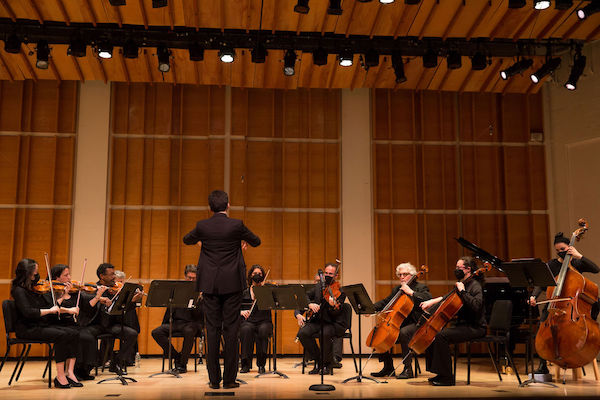Parlando springs forward with pastoral American works, old and new
There’s a lot going on at Parlando events.
The chamber ensemble’s Sunday afternoon concert at Merkin Hall followed the established format of conductor Ian Niederhoffer introducing and discussing the music from the stage—along with two of the composers—the program had a per-piece rating of presumed difficulty for newish classical music listeners, and all of this fell under a theme, “Spring Forward.”
This all worked surprisingly well, because the fundamental focus was around the music, via a logically organized program. The theme was a pun connecting the change of seasons to Copland’s Appalachian Spring (a ballet about a place and not a time of year), which concluded the afternoon. It also occluded what Niederhoffer revealed was the real unifying concept of the program, an exploration of “what makes American classical music American,” as he said from the stage. In his view, this was a pastoral aesthetic that brought together Copland with pieces by Mason Bynes, inti figgis-vizueta, Jerod Impichchaachaaha’ Tate, and Anna Roberts-Gevalt.
While that reductionist view played into cliched myths about the supposed rural authenticity of this country and left out the tremendous body of urban music, it was a satisfying concert with a lineup of well-made pieces, played with care. Bynes’ Spring, Sprang, Sprung and figgis-vizueta’s ensemble forecast touched on the season and the weather, and had similar foundations, both starting with small ideas that coalesced into something larger.
Bynes explained that her piece responded to Copland, and Niederhoffer made the point that her work, and all the others on the program, shared the same 13-piece instrumentation of Appalachian Spring. Spring, Sprang, Spring was a graceful reworking of some of the themes from Copland’s piece, and Parlando gave it a sweet and delicate performance that built up a gentle glow.
Even with the hardest rating on the program (five eighth notes that meant “the most esoteric, avant-garde classical music”), ensemble forecast went down easy. This was predominately a graphic score, calling for the musicians to improvise under the conductor’s guidance. This meant some non-standard techniques, like bowing the back of a violin, but the shape and intention of the music was clear—on the technical side, that mean moving towards ensemble bowing, and on the musical side, the feeling of particles of sound coming together into a mighty rush of wind. While the very premise of “difficult music” is suspect, one images that a more experienced group of improvisors would deliver a more avant-garde experience with this score. Still, this was a solid performance.
The next two pieces told stories. Tate’s Spirit Chief Names the Animal People did so explicitly, with a narrator delivering the composer’s adaptation of Chickasaw folklore, while Imagine Sarah, Between Marches, by Roberts-Gevalt, was more abstract.
Tate’s adaptation told how the coyote got his name and place in the universe, while Roberts-Gevalt took the historical character of Sarah Ogden Gunning, a musician and labor activist, and inserted her own idea of how Gunning’s inner life might be in moments of rest, between marches.
Spirit Chief was unexpectedly stolid, musical episodes interspersed with spoken word narratives, on the lines of Peter and the Wolf but with a rigid separation between words and music. Parlando gave the piece plenty of spirit, but the composition itself seemed wanted in flexibility and space to breath.
Imagine Sarah on the other hand was all about breathing, with a feeling of stillness and being in the moment that allowed the listener to open up their own imagination about the inner life of this remarkable figure.
Appalachian Spring sounded even more singular and refreshing after hearing these uneven descendants. The Parlando string sound kept improving throughout the concert and reached its peak here, with strong intonation and a full sound from the violas and cellos. The group emphasized the clear-cut orchestration and form, and played the syncopated polyrhythms and multiple pulses with confidence. While the fast dance music that precedes the conclusion didn’t have the full style and elan that’s in the notes, the final bars were absolutely lovely.

